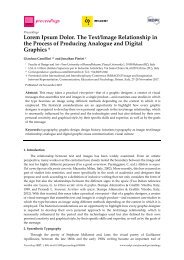proceedings-01-00898
Create successful ePaper yourself
Turn your PDF publications into a flip-book with our unique Google optimized e-Paper software.
Proceedings 2<strong>01</strong>7, 1, 898 8 of 10<br />
their user-friendliness had two effects. Whereas, in the short term, it is true that there was a<br />
proliferation of far from excellent designs, the opening up of the profession to non-designers also<br />
resulted in a boom in experimentation, generating aesthetics that would have been hard to imagine<br />
beforehand [12].<br />
These transformations had a particular impact on the design of typefaces, a highly specialist<br />
sector, and therefore largely inaccessible to the majority, in which the technical component of design,<br />
which we could almost describe as artisanal, constitutes an important part of the design process in<br />
which separating conception from production is less immediate. With the introduction of software<br />
that made it possible to design types like digital outlines through the management of Bézier<br />
curves—like Ikarus, but above all Fontographer and FontStudio—the scenario rapidly evolved. In<br />
this first phase, a lot of effort went into overcoming technological limitations, such as the low<br />
resolution of screens, by specially designing fonts for the new digital environment—Bitstream<br />
Charter by Matthew Carter, for example, or Stone by Sumner Stone for Adobe—or developing<br />
aesthetic solutions capable of establishing themselves as expressions of their time. This was the case<br />
with Californian type foundry Emigre owned by Zuzana Licko, whose characters are hybrid<br />
creatures with a markedly digital feel, or the Beowolf font by Erik van Blokland and Just van Rossum<br />
which, exploiting the limitations imposed by Post Script print technology, permits the production of<br />
infinite random variants of the design, echoing the spontaneity of handwriting.<br />
The typeface, now defined as a set of digital information, firstly in PostScript and TrueType and<br />
then in OpenType (from 1996), had become a genuine piece of software that not only included a<br />
number of glyphs, alphabetical and non-alphabetical symbols defined in a vector format, but also<br />
contained information that determined the functioning of the font during the composition phase.<br />
The definition of a typeface as a system and not just an original design is certainly not a<br />
prerogative of digital technology. For Noordzij, typography with movable type is writing using<br />
prefabricated letters which are juxtaposed as necessary, and it is this modularity aimed at<br />
reproduction that sets it apart from lettering, the study and design of a defined series of letters,<br />
designed ad hoc for a specific use [13]. The approaches of the typeface designer and the graphic<br />
designer to the text/image relationship therefore appear to be distinct from one other. Nevertheless,<br />
many typeface designers have sought to go beyond, anticipating the use of typographical systems<br />
structured to varying different degrees. In fact, going right back to the era of “warm” composition,<br />
some experimental projects used the systematic structure of the typeface, one example being the<br />
Fregio Mecano typeface produced and distributed by the Nebiolo type foundry in the 1920s, which<br />
consisted of a set of geometric shapes that could be assembled to create letters and images. Digital<br />
technologies have made it possible to maximise the systemic potential of the typeface. This is what<br />
happened, for example, with perhaps the most common typographical system, that of the family of<br />
weights and styles. Back in 1956 Frutiger designed Univers, envisaging it as a series of variants<br />
identified through numbers rather than names, but it was in 1994, with Thesis by Lucas De Groot,<br />
that the concept of the super family was born with classes normally treated separately (Sans and<br />
Serif) grouped together and a Mix version introduced.<br />
But what attributes can vary and which must remain unchanged to ensure that different<br />
designs continue to belong to the same family? In some contemporary works the characters become,<br />
as was the case with Fregio Mecano, toolboxes that the graphic designer can freely dip into, taking<br />
explicit advantage of their semi-finished nature. This was the case with the History typeface by Peter<br />
Biľak: a collection of 21 fonts, a layered system inspired by the historical evolution of typography.<br />
Based on a common skeleton, sharing widths and other metric characteristics, the various typefaces<br />
can be freely combined, giving the graphic designer the opportunity to produce thousands of styles.<br />
In design terms, the importance of the collection’s versatility is underlined by the fact that, in<br />
addition to the typeface, Bil’ak also released an online editor to make it easier to use.



